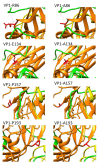Conserved Residues Adjacent to ß-Barrel and Loop Intersection among Enterovirus VP1 Affect Viral Replication: Potential Target for Anti-Enteroviral Development
- PMID: 35215957
- PMCID: PMC8877150
- DOI: 10.3390/v14020364
Conserved Residues Adjacent to ß-Barrel and Loop Intersection among Enterovirus VP1 Affect Viral Replication: Potential Target for Anti-Enteroviral Development
Abstract
Enterovirus genus has over one hundred genotypes and could cause several kinds of severe animal and human diseases. Understanding the role of conserved residues in the VP1 capsid protein among the enterovirus genus may lead to anti-enteroviral drug development. The highly conserved residues were found to be located at the loop and ß-barrel intersections. To elucidate the role of these VP1 residues among the enterovirus genus, alanine substitution reverse genetics (rg) variants were generated, and virus properties were investigated for their impact. Six highly conserved residues were identified as located near the inside of the canyon, and four of them were close to the ß-barrel and loop intersection. The variants rgVP1-R86A, rgVP1-P193A, rgVP1-G231A, and rgVP1-K256A were unable to be obtained, which may be due to disruption in the virus replication process. In contrast, rgVP1-E134A and rgVP1-P157A replicated well and rgVP1-P157A showed smaller plaque size, lower viral growth kinetics, and thermal instability at 39.5°C when compared to the rg wild type virus. These findings showed that the conserved residues located at the ß-barrel and loop junction play roles in modulating viral replication, which may provide a pivotal role for pan-enteroviral inhibitor candidate.
Keywords: Enterovirus; VP1; antiviral; conserved residues; replication.
Conflict of interest statement
No potential conflict of interest relevant to this article are reported.
Figures







Similar articles
-
The role of conserved arginine and proline residues in enterovirus VP1 protein.J Microbiol Immunol Infect. 2022 Aug;55(4):590-597. doi: 10.1016/j.jmii.2022.01.004. Epub 2022 Feb 17. J Microbiol Immunol Infect. 2022. PMID: 35232679
-
Identification of Positively Charged Residues in Enterovirus 71 Capsid Protein VP1 Essential for Production of Infectious Particles.J Virol. 2015 Oct 28;90(2):741-52. doi: 10.1128/JVI.02482-15. Print 2016 Jan 15. J Virol. 2015. PMID: 26512078 Free PMC article.
-
New class of early-stage enterovirus inhibitors with a novel mechanism of action.Antiviral Res. 2017 Nov;147:67-74. doi: 10.1016/j.antiviral.2017.10.004. Epub 2017 Oct 7. Antiviral Res. 2017. PMID: 28993161
-
The efficacy of viral capsid inhibitors in human enterovirus infection and associated diseases.Curr Med Chem. 2007;14(8):847-56. doi: 10.2174/092986707780363032. Curr Med Chem. 2007. PMID: 17430140 Review.
-
Combating enterovirus replication: state-of-the-art on antiviral research.Biochem Pharmacol. 2012 Jan 15;83(2):185-92. doi: 10.1016/j.bcp.2011.08.016. Epub 2011 Aug 26. Biochem Pharmacol. 2012. PMID: 21889497 Review.
Cited by
-
Advances in anti-EV-A71 drug development research.J Adv Res. 2024 Feb;56:137-156. doi: 10.1016/j.jare.2023.03.007. Epub 2023 Mar 30. J Adv Res. 2024. PMID: 37001813 Free PMC article. Review.
-
Substitution of Coxsackievirus A16 VP1 BC and EF Loop Altered the Protective Immune Responses in Chimera Enterovirus A71.Vaccines (Basel). 2023 Aug 14;11(8):1363. doi: 10.3390/vaccines11081363. Vaccines (Basel). 2023. PMID: 37631931 Free PMC article.
References
-
- Walker P.J., Siddell S.G., Lefkowitz E.J., Mushegian A.R., Adriaenssens E.M., Alfenas-Zerbini P., Davison A.J., Dempsey D.M., Dutilh B.E., Garcia M.L., et al. Changes to virus taxonomy and to the international code of virus classification and nomenclature ratified by the international committee on taxonomy of viruses (2021) Arch. Virol. 2021;166:2633–2648. doi: 10.1007/s00705-021-05156-1. - DOI - PubMed
-
- Chan L.G., Parashar U.D., Lye M.S., Ong F.G., Zaki S.R., Alexander J.P., Ho K.K., Han L.L., Pallansch M.A., Suleiman A.B., et al. Deaths of children during an outbreak of hand, foot, and mouth disease in Sarawak, Malaysia: Clinical and pathological characteristics of the disease. For the outbreak study group. Clin. Infect. Dis. 2000;31:678–683. doi: 10.1086/314032. - DOI - PubMed
Publication types
MeSH terms
Substances
LinkOut - more resources
Full Text Sources

